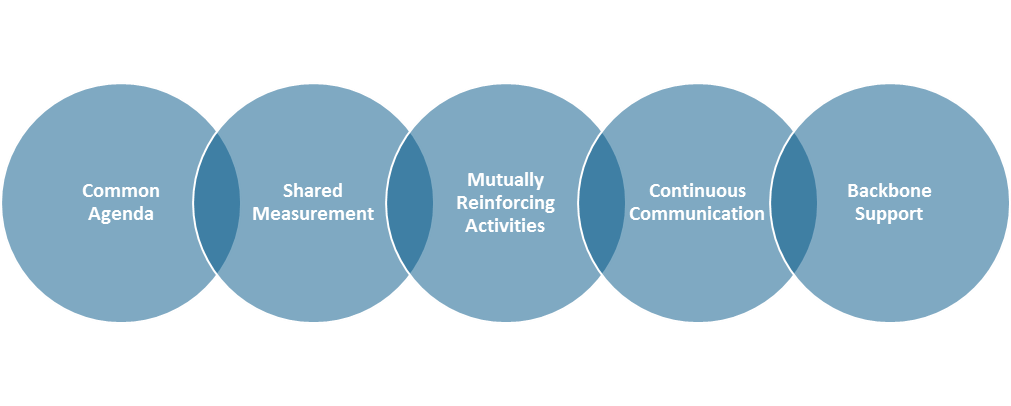Learning Objectives & Outcomes
After completing this module, participants will be able to:
- Understand and articulate the reasons community colleges should engage in collective impact.
- Articulate the definition of and framework for collective impact partnerships.
- Understand how community colleges have used collective impact strategies to benefit students.
- Apply collective impact strategies in scenarios and case studies.
- Develop an implementation plan to build and sustain a collective impact partnership to meet a student success goal for their college.
Module Overview
Community colleges today are being pressed to deliver significantly higher numbers of quality credentials to a more diverse population, without the infusion of additional public funding. Given the academic and social challenges faced by the growing number of first-generation college-goers, this is a complex and daunting task that requires colleges to look beyond the corners of their campuses and existing means for delivering education.
At the same time, few community college students are just college students or earn undergraduate credentials at only one institution. Many community college students work, often holding full-time jobs while going to school. Increasing numbers are also attending high school, with dual enrollment students estimated to account for up to a quarter of new community college enrollments in 2016. Additionally, many community college students do not graduate from the institution at which they first matriculated, “swirling” into other two- and four-year colleges and universities.
To deliver and resource the education students need in the face of rapidly changing expectations and conditions, exceptional community college leaders are developing new strategic partnerships with other cross-sector organizations in the education-to-employment ecosystem. This module focuses on the dynamics of building effective partnerships between colleges and the neighboring organizations that share complementary missions, using the framework of an emerging field known as “collective impact.”
Collective impact focuses on the power of partnerships across multiple organizations to achieve a common social goal. Most colleges today actively engage in partnerships with key stakeholders. These partnerships are likely focused on a specific project or goal, such as a dual enrollment or internship program, with each of the partners contributing their efforts in support of an agreed-upon outcome. Based on partnerships that have proven highly productive in achieving specific goals, collective impact projects aim to take these elements of strategic partnerships and apply them to create a broader impact: when several organizations work together, with strong structures and communication, more can be accomplished.
What differentiates a collective impact partnership from the more traditional partnership is the structure and the interdependency of five core elements as defined by John Kania and Mark Kramer in Collective Impact (Stanford Social Innovation Review, 2011): common agenda and goals, shared measurement, mutually reinforcing activities, continuous communication, and backbone support.
While every element of the above definition has been practiced as long as partnerships have existed, collective impact projects aim to create the conditions and discipline needed to ensure that every element is achieved. This structured approach to community problem solving holds particular promise for community colleges because the educational continuum starts at K-12 (or community-based adult education) and continues on through community colleges, four-year universities, and post-education employment, posing a set of challenges related to curricular alignment, actionable data, and the needs of a diverse student body that can be effectively addressed only through multi-institutional partnerships.
In this module, participants will apply the framework of collective impact to community college partnerships that engage four essential partners: K-12 schools, community-based organizations, employers, and four-year colleges and universities. We review the literature and examples of successful collective impact projects, focusing on how community colleges can work effectively with a discrete number of organizations, outside of the community college sector, to harness the joint energy of the collective in achieving their joint goals.
Preparation
Pre-Reading
- Aspen Institute, College Excellence Program. (2017). Promoting equity and student success through transfer in partnership: A case study of two at-scale approaches. Located in the Appendix of this module: p. 24.
- Esch, C., & Whitmire, R. (April 2010). Pathway to the baccalaureate: How one community college is helping underprepared students succeed. New America Foundation. Retrieved from https://www.newamerica.org/education-policy/policy-papers/pathway-to-the-baccalaureate/
- (2013, September 10).Collective Impact Study: The Road Map Project. Retrieved from http://www.fsg.org/publications/road-map-project
- Hanleybrown, F., Kania, J., & Kramer, M. (2012, January 26). Channeling change: Making collective impact work. Stanford Social Impact Review.
- Kania, J., & Kramer, M. (2011, winter). Collective impact. Stanford Social Innovation Review. Retrieved from http://www.ssireview.org/articles/entry/collective_impact
- Klempin, S. (2016, February). Establishing the backbone: An underexplored facet of collective impact efforts. CCRC Research Brief.
Module Outline
- Kick-Off Activity: Readiness Assessment
- Why Collective Impact?
- Key Learning
- Group Application Activity: Asset Mapping
- The Fundamentals of Collective Impact
- Common Agenda and Goals
- Shared Measurement
- Mutually Reinforcing Activities
- Continuous Communication
- Backbone Support
- Putting It All Together
- Individual Application Activity: Planning for Partnership
- On-Campus Activity: Interview and Present

